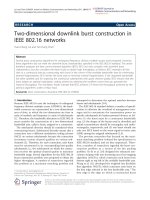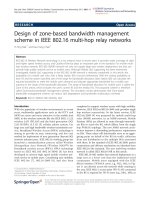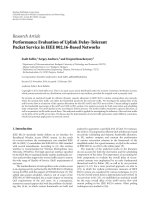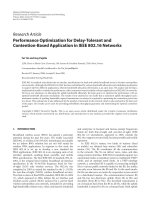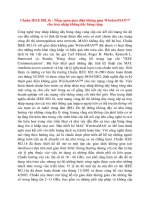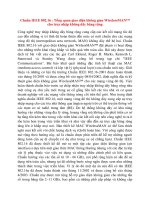Wireless networks - Lecture 42: IEEE 802.16
Bạn đang xem bản rút gọn của tài liệu. Xem và tải ngay bản đầy đủ của tài liệu tại đây (339.93 KB, 20 trang )
Wireless Networks
Lecture 42
IEEE 802.16
Dr. Ghalib A. Shah
1
WiMAX Basics
WiMAX or 802.16 is an effort by the IEEE to develop a
standards based air interfaces for the licensed and
unlicensed radio frequencies from 2 to 66 GHz
The approach they have taken is to develop a common
MAC – Media Access Control sub layer of the data link
layer
Then to offer differing physical layers to accommodate
the needs of the different frequencies and regulatory
environments
The IEEE believes that the existing approaches to
delivering wireless data services do have the potential
for long term growth when used outside of the local
area network
2
2
IEEE 802.16 Overview
Family of standards for wireless metropolitan
area networks (WMAN)
Provide broadband (i.e., voice, data, video)
connectivity
Specifies the air interface, including the
medium access control (MAC) layer and
multiple physical layer specifications
802.16e is an amendment to 802.16d (fixed or
nomadic wireless broadband) to support
mobility
► Vehicular speeds up to 75 mph
3
WiMAX Forum
Formed in J une 2001 to promote conformance
and interoperability of the 802.16 standard
Develops “system profiles” that define
mandatory and optional features of standard
IEEE®802.16e Mobile
Broadband Wireless
Amendment
Mandatory and
Optional Features
Mobile WiMAX
System Profile
Release-1
IEEE®802.16-2004
Fixed Broadband
Wireless Standard
[1]
4
802.16 Evo lutio n
802.16
Dec 2001
• Original fixed wireless broadband air Interface
for 10 – 66 GHz
• Lineofsight only
• PointtoMultiPoint applications
802.16a
Jan 2003
• Extension for 211 GHz
• Nonlineofsight
• PointtoMultiPoint applications
802.16d
Oct 2004
• Revised and replaced previous versions
• WiMAX System Profiles
802.16e
Dec 2005
[2]
• MAC/Physical layer enhancements to support
subscribers moving at vehicular speeds
5
Characteristics of 802.16 Frequency Ranges
10 - 66 GHz
►
►
►
►
Short wavelength
Line-of-sight (LOS) required
Negligible multipath
The commonly used frequencies in this range are
10.5, 25, 26, 31, 38, and 39 GHz
2 – 11 GHz
►
►
►
►
Longer wavelength
LOS not required
Improved range and in-building penetration
Multipath effects may be significant
6
IEEE 802.16 Standard
802.16
802.16d/Hipe rMAN
802.16e
Co mple te d
De c e mbe r 2001
June 2004 (802.16d)
Es timate 2005
S pe c trum
10 66 GHz
< 11 GHz
< 6 GHz
Channe l
Co nditio ns
Line o f S ig ht Only
No n Line o f S ig ht
No n Line o f S ig ht
Bit Rate
32 – 134 Mbps in
28MHz c hanne l
bandwidth
Up to 75 Mbps in 20MHz Up to 15 Mbps in
c hanne l bandwidth
5MHz c hanne l
bandwidth
Mo dulatio n
QPS K, 16QAM and
64QAM
OFDM 256 FFT
QPS K, 16QAM, 64QAM
S c alable OFDMA
128 to 2048 FFT
Mo bility
Fixe d
Fixe d
Po rtable
Channe l
Bandwidth
s
20, 25 and 28 MHz
1.75 to 20 MHz
1.75 to 20 MHz
7
Why do we need broadband wireless access?
Fill the gap between high data rate wireless
LAN and very mobile cellular networks.
Wireless alternative to cable and DSL for lastmile broadband access
► Developing countries
► Rural areas
Provide high-speed mobile data and
telecommunications services
8
802.11 v 802.16
► 802.11’s media access control protocol is optimized for shorterrange topologies
► It also was not designed to serve a large number of users
► Wireless MAN, on the other hand, was designed to solve the
problems of delivering wireless broadband networks over longer
distances and through more difficult environments, such as
heavily wooded areas
9
9
Comparison 802.11 and 802.16
Technology 802.11
802.16
Range
< 300 feet
< 30 Mile ( typical 3~4)
Coverage
Optimized for
indoor short range
2.7 bps/Hz peak.
<= 54Mbps in 20MHz
Outdoor LOS & NLOS
Data rate
5bps/Hz peak,
<100Mbps in 20 MHz
Scalability 110 CPE CSMA/CA
1 hundreds CPE TDMA
QOS
On demand BW voice
Video, data10
No QOS
Network Architecture
Source: WiMAX Nuts and Bolts – Steve Hilton [3]
11
Physical Layer
Five physical layer modes
802.16d
802.16e
Designation
Applicability
WirelessMAN-SC
10 -66 GHz
WirelessMAN-SCa
Below 11GHz
Licensed bands
WirelessMAN-OFDM
Below 11GHz
Licensed bands
WirelessMAN-OFDMA
Below 11GHz
Licensed bands
WirelessHUMAN
Below 11GHz
Licensed-exempt bands
12
Orthogonal Frequency Division Multiplexing
(OFDM)
Multiplexing technique that divides the channel
into multiple orthogonal sub channels
Input data stream is divided into several
substreams of a lower data rate (increased
symbol duration) and each substream is
modulated and simultaneously transmitted on a
separate sub channel
High spectral efficiency, resilient to
interference, and low multi-path distortion
13
Conventional FDM and OFDM
Source: Broadband Wireless Access (W-PAN, W-LAN, WiMAX,
14 Wi-Mob) (including
OFDM concepts) - A. K. Seth [4]
Orthogonal Frequency Division Multiple Access
(OFDMA)
Multiple-access/multiplexing scheme
► a multiple-access/multiplexing scheme that provides
multiplexing operation of data streams from multiple
users onto the downlink sub-channels and uplink
multiple access by means of uplink sub-channels.
► Dynamically assign a subset of subchannels to
individual users
WirelessMAN-OFDMA based on scalable
OFDMA (SOFDMA)
► Support scalable channel bandwidths from 1.25 to
20 MHz
15
Other Physical Layer Features
Hybrid automatic repeat request (HARQ)
► Adjusts automatically to channel conditions
► Receiver saves failed transmission attempts to help future
decoding
•
Every transmission helps increase probability of success
Multiple-in Multiple-out (MIMO)
► Multiple antennas on sender and receivers
► Takes advantage of multi-path
► Increased spectral efficiency
16
TDD
The 802.16e PHY supports TDD and Full and HalfDuplex FDD operation;
To counter interference issues, TDD does require
system-wide synchronization;
TDD is the preferred duplexing mode for the following
reasons:
► TDD enables adjustment of the downlink/uplink ratio to
efficiently support asymmetric downlink/uplink traffic,
► Unlike FDD, which requires a pair of channels, TDD only
requires a single channel for both downlink and uplink
providing greater flexibility
► Transceiver designs for TDD implementations are less
complex and therefore less expensive.
17
MAC Layer
Connection-oriented
A fundamental premise of the MAC architecture
is quality of service (QoS)
QoS provided via service flows
18
19
MAC Layer
Service Specific Convergence
Sublayer
Interface to higher layer
protocols, classifies
incoming data, etc.
MAC Common Part Sublayer
Core MAC functions (i.e.,
scheduling, connection
maintenance,fragmentation),
QoS control
Privacy Sublayer
Encryption, authentication,
secure key exchange
20
